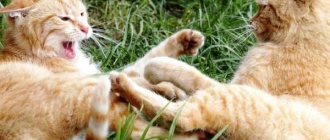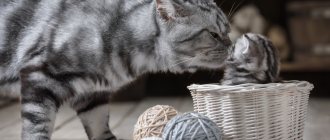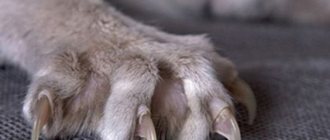Banal reasons why a cat is lethargic
To begin with, let’s agree that the reasons why a cat has become lethargic can be quite banal. So, the animal will look apathetic in the heat
when the air temperature outside the window and in the room is above +30 degrees.
A pet that is tired or has eaten a hearty meal
.
And there are simply phlegmatic cats
, which almost always look too calm and sleepy.
The following picture is also not uncommon: an old cat constantly sleeps and is lethargic. And it’s not at all necessary that the pet is in pain, it’s just that there is not enough strength left for cheerfulness
, no matter how sad it may be.
Cats often behave very calmly and even lethargically after estrus.
, more precisely, after mating, if there is a result of successful mating with a cat in the form of pregnancy. During the first 3-4 weeks, the expectant mother cat sleeps a lot and eats little due to toxicosis, which should not cause much concern to the owner.
In addition, medications prescribed by a veterinarian
(for example, the same antihistamines or sedatives).
Also, for 1-2 days the animal is unusually calm and inactive after anesthesia
, while the drugs used for anesthesia are removed from the body.
Breed of a sad cat - description and characteristics
Can an ordinary cat become the most popular and earn millions of dollars? Yes, if it is the most gloomy cat in the world. The breed of a sad cat is the biggest mystery even for its owners.
The sad cat who “woke up famous”
The history of the unique “Angry (Sad) Cat” - “Grumpy Cat” began in the year of his birth - 2012. It must be said right away that the sad cat was actually a small cat named Tartar Sauce, or simply Tard for short. Her owner Tatana Bundesen worked as a waitress in a small cafe.
© shutterstock
On September 22, 2012, Tatana's brother Brian posted on the social network Reddit a photo of little Tard, with a deformed short nose and a very sad, even angry, expression in her eyes. This eternally gloomy face was so loved by users of social networks that thousands and thousands of people almost immediately began posting and liking her photos.
Literally the next day, “Grumpy Cat” became a world celebrity. Four days later, the hostess quit her job because her income from advertising on social networks began to bring in an amount much higher than the waitress's salary.
However, this was not easy, because I had to take thousands of pictures, select the best ones, come up with titles and descriptions for them, and continue to publish them on social networks almost every day.
Breed "Grumpy Cat"
Mom Tard, a mongrel street cat, was picked up by her owner Tatana on the street. The cat found herself in a very difficult situation. She gave birth to kittens and was simply exhausted, lying on the ground motionless, barely showing signs of life .
The kind girl did not even suspect that she had found her happiness in life when she helped an unfortunate animal. I took her home and gave her water to drink, and adopted the newborn kittens. Among them was a kitten with a slightly deformed muzzle, whom Tatana named Pokey.
It was the elder brother Tard.
A year later, the mother cat gave birth to several more kittens, including the future world Internet star, “Grumpy Cat.”
Tard's father, as the owner suggests, is a neighbor's street cat, also a mongrel. A real cat “macho”, whose skin is striped with the scars of cat battles. His appearance is quite banal - a white belly, a striped back and dark paws.
Therefore, the breed of a cat with sad eyes is very uncertain. Although, if you look closely, you will notice that based on the color of its face, the breed of the saddest cat in the world could be identified as Burmese. But, looking at her short legs, you can see that the breed of a dissatisfied cat is somewhat reminiscent of a munchkin.
© shutterstock
Tard is a mongrel cat who was born with a deformed muzzle and has problems with her hind legs. The baby walks poorly, often falls, and her movements are somewhat retarded. An angry cat meows in a somewhat strange voice. Despite everything, she is very affectionate, friendly to strangers, loves to play, like all cats in the world.
Achievements of "Grumpy Cat"
- -The Grumpy Cat page has more than a million subscribers.
- featuring the saddest cat in the world, sweet Tard has racked up an incredible 15 million views.
- In 2013, "Grumpy Cat" was awarded the Meme of the Year Award by the Webby Awards.
- The same year the book “Grumpy Cat. An Angry Book from the Angriest Cat in the World."
- The famous cat food manufacturer Friskies invited the sad cat Tard to advertise its products, naturally paying her owner very impressive fees for this very “difficult” cat work.
- In 2014, a sequel to the book from the saddest cat in the world was published.
- In 2012, Crumpy Cat Ltd. represented by the owner of the sad cat, entered into an agreement with the American company Grenade, which produces coffee, in the amount of 150 thousand dollars. Tarde's image was supposed to appear on the packaging of the Grampuccino drink. However, the company began to place a portrait of a sad cat on packaging of other drinks, on T-shirts, mugs, etc. The result was a lawsuit from T. Bundesen against the Grenade company. The lawyer for the owner of the sad cat won the case, and the owner Tard received 701 thousand dollars.
- Mistress Tard opened her own business and successfully sells funny T-shirts with funny inscriptions and a portrait of her sad cat.
- In general, over two years, from various sources, the saddest cat earned his owner $100 million. This significantly exceeds the fees of the most famous Hollywood stars.
PreviousNext
Source: https://KOTiKo.ru/vopros-otvet/poroda-grustnogo-kota-opisanie-i-harakteristika.html
Serious reasons why a cat is lethargic
However, the lethargy of a pet should not be taken lightly: it happens that a cat is lethargic due to illness:
- Stress
. If the cat has become lethargic, it may be due to a mental disorder, which can occur in pets for various reasons, for example, when moving to a new home, changing owners, having a new pet in the house, or suddenly switching to new food. The main signs of stress in cats include lethargy (although in some cases the pet may look very agitated), refusal to eat or literally gorging, constant licking of fur (even to the point of bald spots), bad behavior (the cat marks and shits outside the tray, screams loudly, gnaws flowers, destroys furniture, etc.). As a rule, stress goes away on its own if you regularly communicate and play with the cat, but in some cases it is necessary to take sedatives;
Poisoning
. If the cat has become lethargic, trembles, breathes loudly and heavily, refuses to eat, has vomiting and/or diarrhea, saliva runs heavily, the mucous membranes have turned red or blue, the temperature has risen or dropped (normal temperature in adult cats is from 37 to 38 .5 degrees, for kittens - from 39 to 39.5 degrees), there is a suspicion that the animal was seriously poisoned by something. What can cause poisoning in pets? Anything: rotten fish, houseplant juice, washing powder, rodent poison and much more;
Blood pressure surges
. There is a possibility that the cat is lethargic all the time if she has low or high blood pressure, which normally ranges from 105/65 to 135/95 mmHg. Signs of high blood pressure include apathy, red eyes, dilated pupils, blurred vision (this can be calculated by observing an animal that will bump into walls or furniture when walking), noises during breathing, swelling of the extremities, vomiting, nosebleeds, high pulse (more than 140-150 beats per minute). Low blood pressure can be recognized by constant drowsiness, loss of appetite due to nausea, decreased heart rate (below 80 beats per minute), loss of consciousness;
Endocrine disorders
. In some situations, a cat is lethargic due to diabetes mellitus or Cushing's syndrome. Plus, don’t forget about hormonal imbalance, which often occurs in pets after giving birth, and even after sterilization, a lethargic cat is common. You can figure out from the following symptoms that your pet has endocrine problems: extreme thirst, frequent urination, changes in appetite (the cat either begins to eat very little or constantly asks to be fed), deterioration in the condition of the coat and skin, an increase in the volume of the abdomen, weight fluctuations, cramps, heaviness of gait, blurred vision, low motor activity as a result of weakening muscles;
Diseases of the musculoskeletal system
, for example, osteochondrosis, arthritis, joint dysplasia, bone fractures, joint dislocations, ligament rupture. Find out that a cat has problems of this nature simply by the following symptoms: lameness, refusal to jump, change in gait, pain (the cat growls and bites if the owner touches the sore spot), swelling in the area of the affected joints, refusal to eat and apathy. Cats with diseases of the locomotor system often do not sharpen their claws, take poor care of their coats, and do not wash themselves;
Oncology
. If the cat is lethargic, lies down most of the day, eats very little or refuses food at all, is rapidly losing weight and meows pitifully, suffers from vomiting, diarrhea and internal bleeding, the development of cancer can be suspected. Other signs of cancer in cats include bad breath, the appearance of ulcers and minor swelling on the body (in some cases the tumor is visible to the naked eye), aimless wandering around the apartment;
How to calm a cat after stress
If you cannot avoid a stressful situation, you need to help your cat cope with stress.
The owner’s algorithm of actions should be as follows:
- Find and eliminate the cause of stress.
- Divert the cat's attention from the stress factor with the help of games, favorite toys, treats, and affection.
- Offer physical activity. Sports playgrounds for cats or a walk in the fresh air will help with this. Physical activity effectively distracts and entertains the animal. However, you need to ensure that physical activity is commensurate with the age and condition of the pet. Overload is additional stress for the cat’s nervous system.
- Give the cat a lot of attention. Stroke your pet, talk to him affectionately, scratch behind the ear. Do whatever makes him happy and relaxes.
- Use aromatherapy. The aroma of bergamot, mint and lavender causes a sedative effect in cats, this will help calm the cat after stress.
- Adjust your cat's diet. After stress, cats benefit from: fish oil, sea fish, olive oil, quail eggs.
What to give your cat for stress
All sedatives that will help relieve stress in a cat should be prescribed by a veterinarian. Do not self-medicate so as not to aggravate the situation and increase stress. Next, let's talk about what you can give your cat for stress.
Types of sedatives:
- drops;
- pills;
- collars;
- spray.
Anti-stress medications for cats:
- Stop stress, Api-San. A medicinal modulator of cat behavior based on the drug phenibut and a complex of plant extracts: hops, peony, motherwort, Baikal skullcap. Price: 160 – 175 rub.
- Stop stress plus. Relieves excitability, fear and aggression. Price: 200 – 230 rub.
- Relaxivet. Calming tablets for animals. Price: 150 – 65 rub.
- Relaxivet, calming spray. Therapeutic cosmetics that correct cat behavior. Price: 220 – 250 rub.
- Beaphar No Stress Spot On. Soothing drops in pipettes. Price: 600 – 650 rub.
- Beaphar No Stress Home. Spray for correcting cat behavior after stress. Price: 690 – 750 rub.
- GOOD No stress. Homeopathic collar for cats with valerian extract. Price: 350 – 380 rub.
Alarming symptoms
— The cat refuses to eat or eats very little. This happens when an animal’s sexual instincts awaken. But if there are no specific signs of sexual desire, refusal to eat is an alarming symptom.
When sexual heat occurs, the cat screams, raises the back of its body, rolls on the floor, sometimes becomes more affectionate or, on the contrary, aggressive for no reason.
— The animal does not exhibit hunting instincts: the cat does not try to play, does not react to rustling moving objects, etc.; the animal tries not to make unnecessary movements.
— The cat has stopped “taking care of itself”: it doesn’t lick itself, doesn’t clean its fur.
- Body temperature is increased. Not every animal will allow you to measure its body temperature with a thermometer, but when you hold a cat in your arms, you can feel that it is hotter than usual. The normal body temperature of a cat is 38 degrees Celsius.
A cat's body temperature can be measured by inserting a thermometer into the rectum.
- The stool has changed: it has become too liquid, an admixture of blood has appeared, or, on the contrary, there has been no stool for more than two days.
Why else can a cat be sad?
If the animal is healthy, but behaves unusually quietly, perhaps something has changed in the environment, and this is alarming it. Perhaps the cat is afraid of someone or something. Maybe there is a new tenant in the house, a person or an animal? Did the newcomer offend your furry pet?
Or maybe the cat was offended by the owner? Yes, this happens too. Cats, although independent animals, are completely bored without company. She can be angry with her owner for several days if he leaves her alone for a long time.
In any case, if the cat is sad, it is worth giving her a little more affection and attention to her cat problems.
Is the cat lethargic and apathetic? Perhaps she is simply not in the mood, and tomorrow it will change. And if lethargy is accompanied by other symptoms, then it’s worth thinking about, because this may be the first sign of the development of the disease.
Natural Causes of Lethargy
The reasons for a lethargic, apathetic state can be simple and banal. For example, a similar reaction is possible to a change in weather. Most cats are more sensitive to changes in atmospheric pressure and the change from warm to rainy weather with gusts of wind compared to weather-sensitive people. But unlike people, a cat cannot say that it doesn’t feel well or take a pill to normalize its blood pressure. That is why she becomes lethargic, sad and phlegmatic, tries to sleep more and eat less, which is why she seems tired to her owner.
Lethargy in a cat can indicate many reasons for this condition.
You should not force a cat to play or eat; such behavior on the part of the owner can provoke aggression and resentment in the cat. As soon as the clouds clear and the bright sun appears, the pet’s mood will normalize, and she will again become playful and active.
Note! Cats also become drowsy and lethargic during extreme heat; this is how pets save themselves from overheating and dehydration. In hot weather, cats want to drink a lot and exercise little.
Lethargy and drowsiness in a kitten can be a result of boredom. A person has dozens of ways to overcome boredom, but a cat closed within four walls cannot boast of such a variety. For example, if your pet sleeps all day, you need to unobtrusively involve him in playing with one of his favorite toys. If the kitten immediately jumped up and began to play, it becomes clear that he was sleeping, because he had nothing to do. If the kitten lies lethargic and does not respond to play or favorite treats, despite a sunny, fine day outside, it is better to consult a specialist.
Lethargy and drowsiness overcome many cats 3-4 days after sterilization, the first weeks of pregnancy, during which they refuse to eat due to toxicosis. A similar reaction of the body may occur to vaccinations, medications, or anesthesia after surgery. It is worth considering the age of the pet. Weakness in an older cat is normal, because older cats are less active and mobile than younger cats.
The kitten is sleeping because he is bored
How to tell if your cat is sad
(Picture: Getty)
Did you know that cats can get a little sad? Yes, they can, and there are a few signs you should look for to know your kitty is in a bad mood. Cat Protection behavior manager Nicky Trevworth says you should always notice a sad cat. Niki says that if your cat is no longer interested in birds or watching them from the window of the room, or sleeps more than usual, she is sad. She also says that when a cat becomes more withdrawn or hides more than usual, it's a bad sign. It is also the case that the cat becomes less tolerant of people, does not want to jump on laps, furniture or windowsills, or avoids its litter tray. These are bad signs. If your cat is no longer playing, eating or drinking, or has started overeating, your cat may be depressed. And finally, if the cat seems more anxious. They are not sleeping properly, are pacing or acting restless, or if their fur looks unkempt or matted, it is obvious that your cat needs help.
(Picture: Getty)
However, don't worry. There are several things you can do to get your cat to stop frowning and become happy and playful again. Nicki notes, “Find out what’s causing you stress. Take your cat to the vet first to rule out medical causes, since many of the signs of stressed or sad cats are the same signs for cats with medical problems, such as pain. If the veterinarian feels that the underlying cause is behavioral, then contact a qualified animal behavior expert. “Provide your cat with all the resources available around the house. Cats don't like to share, so one resource per cat plus one more in reserve will be enough for you! “Give your cat places to hide and be high up so they feel safe. Cardboard boxes are a fantastic activity for cats. Cats in boxes are like children playing with houses. Nicky advises building a "cat castle" in your home that can't be invaded.
(Picture: Getty)
Nicky continues: “Cats don’t really need friends, so if your cat is sad, it’s not recommended to bring another cat or kitten. “As creatures of habit, cats thrive in routine and predictability. "A pheromone diffuser like Feliway can help the home feel more familiar and calming to the cat." Think of ways to feed your cat to make the food more fun and attractive. For example, you can use a cardboard egg crate to place your cat in, or make a toy that she has to play with to get to the treat.
Nicky added that it's important that you play with your cat - but also give her quiet time when she needs it. She adds: “Give them multiple beds so they can change their sleeping place, just like their wild ancestors did. “Separate the food bowl from the water bowl as they don't like to eat and drink in the same place.
Serious reasons why a cat eats poorly and sleeps a lot and is lethargic
However, such a condition may also indicate a serious illness.
Worms
- depressed state for several days;
- a sharp decrease in appetite or its complete absence;
- weight loss;
- disturbances in the functioning of the gastrointestinal tract (constipation, diarrhea, vomiting, flatulence, rumbling);
A swollen belly in kittens may be due to worms
- the coat is dull and crawling;
- swollen, barrel-shaped belly;
- dry crusts in the corners of the eyes without signs of inflammation;
- detection of traces of blood, fragments or whole worms in feces.
Important! If this disease is detected, your pet should be given an anthelmintic drug, the dosage of which is calculated according to the instructions.
Ticks
The bite of this external parasite can provoke piroplasmosis, the causative agent of which, entering the blood along with the saliva of the tick, spreads through the circulatory system in a matter of days and colonizes red blood cells. Its main goal is to weaken the immune system and disrupt the functioning of internal organs. If left untreated, such a bite can be fatal for the cat.
A burrowing tick can spread infection
If the cat is lethargic, sleeps all the time and eats little, has loose stools, vomiting, red urine and fever, you need to urgently examine it for a tick. The detected parasite must be removed, it is better if this is done by a doctor, because along with the tick’s saliva, the poisons and infection contained in it enter the cat’s body. But it is not always possible to quickly go to the clinic. In this case, you will have to remove the tick yourself using tweezers, a thin strong thread or another tool that can tightly grasp the body of the parasite. It is important to grab the bloodsucker as close to the cat's skin as possible and then carefully twist it clockwise.
For your information! A sharp jerk can tear off the body of the tick, and the head, remaining under the skin, will continue to spread the infection. Sometimes, when extracted, small head parts of the parasite remain under the skin, this is not scary, the cat’s immune system can handle it.











